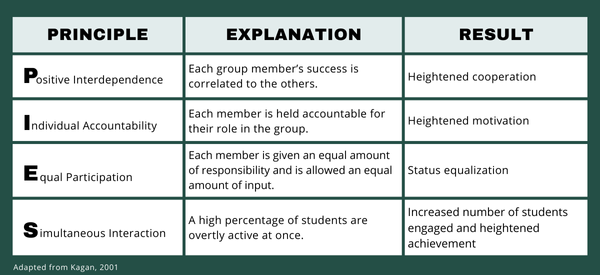Promoting Student Engagement

Today’s classrooms are full of students who are active, curious, and very much connected to the world around them. Creating a learning environment that ignites excitement and interest and initiates effective instruction in new and innovative ways is critical to guiding students to become engaged lifelong learners. To effectively create and sustain classroom engagement, teachers must first understand how students learn, think, and develop.
The Different Types of Student Engagement
When asked about their perception of student engagement, teachers imagine a classroom full of students who have their hands raised, either to ask or answer a question. While this can indeed be an example of student engagement, the fact is that student engagement is comprised of so much more. It involves a shared sense of community, a positive classroom culture where everyone feels safe expressing their ideas and opinions, and the habits of mind to help students realize that mistakes help them learn so they can persevere through productive struggle. To understand the whole picture of what this truly means, one must first understand the three different types of student engagement.
- Behavioral Engagement. Behavioral engagement refers to a student’s participation in classroom learning activities. Students who are behaviorally engaged participate, ask questions, and display fewer disruptive behaviors. According to a study published by the American Journal of Community Psychology, students in classrooms that are organized are more likely to be behaviorally engaged. Classrooms that had positive behavior management strategies, active learning, and high productivity had more effective learning environments. The study also found that students in classrooms with a high level of peer relationships (classroom community) were more engaged throughout the school year (Capella, et al., 2013).
- Emotional Engagement. Emotional engagement refers to feelings and attitudes. Students who are emotionally engaged feel a greater sense of community and are less anxious when it comes to school. Put simply, “For any of us, whether student or teacher, child or adult, to do our best, to achieve our highest potential, we have to care” (Moulton, 2008). The view that students will accept learning new concepts for the sake of being important “later” does not and will not work for a large number of learners. Connecting the curriculum to real-world situations that students care about is one way to develop emotional engagement. This can be done by relating content to real-world issues that affect students and by connecting them to their immediate community. Attaching a purpose to learning elevates emotional connections (Moulton, 2008).
- Cognitive Engagement. Cognitive engagement refers to a student’s investment in learning. Students who are cognitively engaged are more willing to be challenged, try new strategies, and persevere through more difficult concepts (Sutton, 2021). Cognitive engagement relates to how students comprehend and make connections in their learning. A student who is cognitively engaged can reflect and share what they’ve learned and can understand and appreciate how their learning has developed over time (Fisher & Frey, 2021).
It is important to keep in mind that no single type of student engagement is more important than the other, and all three are inextricably linked. Integrating the 3 dimensions of engagement helps students feel more engaged in their learning and overcome attention deficits. Teachers should be aware that developing each type of student engagement ultimately creates a classroom community that is driven and focused, leading to greater student growth.
“Back Pocket” Strategies
When teachers work on increasing student engagement in the classroom, everybody wins. The following tools can be very helpful additions to a teacher’s “back pocket” arsenal of ideas. As an added benefit, these strategies not only work to increase student engagement but also promote a sense of belonging and community, another win for everyone involved.
Cooperative Learning
Cooperative learning, when done correctly, helps to instill a sense of ownership, interdependence, and personal responsibility (Zook, 2018). Cooperative learning is a great strategy to use after students have been given explicit information, as a recovery from a large cognitive load, or as a review. Cooperative learning activities can also be used to help develop teamwork and classroom culture, leading to a greater sense of belonging and community.
Spencer Kagan, a leading proponent of cooperative learning, defines the strategy as “a teaching arrangement that refers to a small heterogeneous group of students working together to achieve a common goal” (Kagan, 1999). Kagan promotes four major elements that are needed for cooperative learning to take place. These four elements, known as P.I.E.S., are key to developing effective cooperative learning activities for students.

Adding Movement
According to the National Education Association, adding movement in the classroom results in better behavior, higher rates of memory, and more focused students (Pantuosco-Hensch, 2019). Mood, energy level, and stress level are also related to movement. Knowing this information empowers teachers to include movement as part of their classroom culture. Movement doesn’t have to mean chaos, though. Thoughtful planning can create movement in the classroom that is organized, geared toward learning goals, and meets the needs of students.
Total Physical Response, or TPR, is a strategy that includes movement in teaching. Teachers who use TPR associate a concept with verbal explanation coupled with a particular movement, thus creating a stronger memory connection with the goal of creating a better recall ability for the student (Richards & Rogers, 2001). While TPR began as a multisensory way to teach English language learners, it can be useful across the curriculum for a wide variety of learner types and concepts.
Promoting student engagement is vital to enhancing the learning experience and improving educational outcomes. While there are many strategies to increase student engagement, learning the different types of engagement and incorporating cooperative learning and movement into your daily routine will create an environment that fosters active participation and meaningful learning.
Are you curious? Want to take a deep dive on this topic?
To learn more about promoting student engagement, visit the Professional Development Institute (PDI) website or our Boosting Student Engagement Using Active Learning Strategies course.
For over 27 years, PDI has provided high-quality and affordable online professional development courses to K-12 teachers worldwide. Our online courses are designed to offer practical strategies that can be implemented in classrooms immediately. All our courses are instructor-led and conducted entirely online. Graduate-level university credit for every PDI online course for teachers is available through the University of California San Diego Division of Extended Studies. PDI offers an extensive catalog of online courses that cover the most critical topics in today's classrooms.
Categories: student engagement
References
Cappella, E., Kim, H. Y., Neal, J. W., & Jackson, D. R. (2013). “Classroom Peer Relationships and Behavioral Engagement in Elementary School: The Role of Social Network Equity.” In American Journal of Community Psychology, 52(3-4), pp. 367-379. doi: 10.1007/s10464-013-9603-5
Fisher, D., & Frey, N. (2021). “New Thinking About Student Engagement.” ASCD. Retrieved 08 Dec. 2022 from https://www.ascd.org/el/articles/show-and-tell-a-video-column-new-thinking-about-student-engagement
Kagan, S. (1999). “Cooperative Learning: Seventeen Pros and Seventeen Cons plus Ten Tips for Success.” Kagan Online Magazine. Retrieved 20 Dec. 2022 from https://docplayer.net/93551049-Cooperative-learning-seventeen-pros-and-seventeen-cons-plus-ten-tips-for-success.html
McDowell, M. (2024, October 15). Cognitive, emotional, and behavioral engagement strategies that work. Edutopia. https://www.edutopia.org/article/student-engagement-dimensions/
Moulton, J. (2008). “Emotional Engagement in Education, Part Three: Take it to the Streets.” Edutopia. Retrieved 19 Nov. 2022 from https://www.edutopia.org/emotional-engagement-education-part-three
Pantuosco-Hensch, L. (2019). “Making Movement a Part of Your Classroom Culture.” National Education Association. Retrieved 19 Jan. 2023 from https://www.nea.org/advocating-for-change/new-from-nea/making-movement-part-your-classroom-culture#:~:text=Physical%20activity%20in%20the%20classroom,%2C%20behavior%2C%20and%20stress%20level
Richards, J. C. & Rodgers, T. S. (2001). Approaches and Methods in Language Teaching. New York, NY: Cambridge University Press.
Sutton, E. (2021). “Student Engagement: Why It’s Important and How To Promote It.” Branching Minds, Inc. Retrieved 18 Nov. 2022 from https://www.branchingminds.com/blog/student-engagement-remote-in-person
Zook, C. (2018). “What Is Cooperative Learning and How Does It Work?” Applied Educational Systems. [Blog post]. Retrieved 19 Jan. 2023 from https://www.aeseducation.com/blog/what-is-cooperative-learning-and-how-does-it-work

View PDI's Catalog of Courses
Check out a list of all PDI graduate-level online courses or sort by grade level or subject area.

Register Now!
Quick access to register for PDI's online courses using our secure system.

Learn More about PDI
Find out how to reach PDI and get answers to any questions you may have.

Access My Course
Access PDI's online learning management system to begin your course.